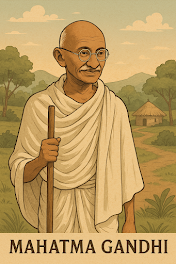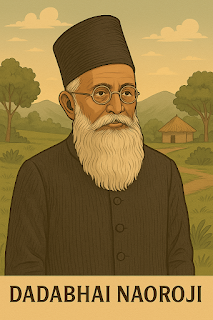🇮🇳 Freedom Fighters of India and Their Inspiring Stories
India’s freedom movement is one of the most powerful independence struggles in world history. It involved peaceful protests, armed revolutions, civil disobedience, and countless sacrifices. The freedom fighters of India gave their lives so that future generations could live in a free and independent India.
Let’s honor the top freedom fighters of India, their journeys, and how they helped shape the nation.
✊ 1. Mahatma Gandhi – The Father of the Nation
🗓️ Life: 1869–1948
🌍 Known For: Non-violence, Civil Disobedience, Salt March
“Be the change you want to see in the world.”
Mahatma Gandhi, also known as Bapu, was the leading figure in India's non-violent freedom movement. He introduced the concept of Satyagraha (truth-force) and inspired millions to protest without violence.
He led several key campaigns:
- Champaran Satyagraha (1917) – to support oppressed farmers
- Non-Cooperation Movement (1920–22) – mass civil disobedience
- Dandi Salt March (1930) – protesting British salt taxes
- Quit India Movement (1942) – demanding an end to British rule
His dedication and leadership made him a global icon for peace and the guiding force behind India’s independence in 1947.
🔥 2. Bhagat Singh – The Revolutionary Legend
🗓️ Life: 1907–1931
🌍 Known For: Assembly Bombing, Lahore Conspiracy Case
“They may kill me, but they cannot kill my ideas.”
Bhagat Singh was a bold and fearless revolutionary who believed that independence should be achieved through direct action. At just 23, he became a symbol of resistance against the British Raj.
Key events:
- Participated in the killing of a British officer to avenge Lala Lajpat Rai
- Threw non-lethal bombs in the Central Assembly to “make the deaf hear”
- Authored powerful letters on revolution, equality, and justice
He was executed on March 23, 1931, along with Sukhdev and Rajguru. That day is now observed as Shaheed Diwas in India.
⚔️ 3. Subhas Chandra Bose – Netaji and the INA
🗓️ Life: 1897–1945
🌍 Known For: Indian National Army, Azad Hind Government
“Give me blood, and I will give you freedom!”
Netaji Subhas Chandra Bose was a charismatic leader who believed that only armed revolution could overthrow British rule. After disagreements with the Indian National Congress, he formed the Azad Hind Fauj (Indian National Army) and sought support from Japan and Germany during World War II.
He famously led the INA in battles across Burma (Myanmar) and Northeast India, inspiring thousands to join the movement. Though his death in a 1945 plane crash remains controversial, his legacy as a patriotic warrior lives on.
👑 4. Rani Lakshmi Bai – The Warrior Queen of Jhansi
🗓️ Life: 1828–1858
🌍 Known For: Revolt of 1857
“We fight for independence. In the words of Lord Krishna, we will if we are victorious, enjoy the fruits of victory.”
Rani Lakshmi Bai, also known as the Queen of Jhansi, was one of the earliest female warriors in India's independence movement. When the British annexed her kingdom under the Doctrine of Lapse, she refused to surrender and raised an army.
Highlights:
- Led her troops with unmatched courage in the 1857 First War of Independence
- Fought valiantly against the British forces in Jhansi, Gwalior, and Kalpi
- Died in battle, becoming a symbol of Indian women's resistance
Her bravery and leadership inspired generations of Indian women to rise against oppression.
🧒 5. Khudiram Bose – The Youngest Martyr of India’s Freedom Struggle
🗓️ Life: 1889–1908
🌍 Known For: Muzaffarpur bombing case
At just 18 years old, Khudiram Bose became one of the youngest revolutionaries to be executed by the British. Inspired by nationalist leaders, he joined Anushilan Samiti, a revolutionary group in Bengal.
In 1908, he and Prafulla Chaki were involved in the attempted assassination of a British judge in Muzaffarpur. The attempt failed, and Khudiram was captured and sentenced to death.
His calm demeanor at the gallows and his fearless smile before his execution turned him into a symbol of youthful patriotism in India. Schools and roads across Bengal and Bihar still carry his name today.
🧕 6. Aruna Asaf Ali – The Grand Old Lady of the Independence Movement
🗓️ Life: 1909–1996
🌍 Known For: Hoisting the flag during the Quit India Movement
Aruna Asaf Ali rose to prominence during the Quit India Movement in 1942, when she hoisted the Indian National Flag at Gowalia Tank Maidan in Bombay, even as most Congress leaders were arrested.
She was dubbed the "Heroine of 1942" and became a symbol of resistance and defiance. She continued underground activities during British suppression and later became a strong voice for civil liberties in independent India.
In 1997, the Indian government awarded her the Bharat Ratna (posthumously), recognizing her lasting contribution to India’s freedom.
📢 7. Gopal Krishna Gokhale – The Moderate Pioneer of Indian Nationalism
🗓️ Life: 1866–1915
🌍 Known For: Social reforms, Indian National Congress leadership
A respected economist and political thinker, Gopal Krishna Gokhale believed in reform over revolution. He was a senior leader of the Indian National Congress and the founder of the Servants of India Society, which aimed to promote education, sanitation, and self-governance.
Gokhale was also the mentor of Mahatma Gandhi, who credited him for shaping his political and moral vision. Although Gokhale’s moderate methods were often criticized by revolutionaries, his contributions laid the groundwork for constitutional reforms in India.
📯 8. Lala Lajpat Rai – The Lion of Punjab
🗓️ Life: 1865–1928
🌍 Known For: Simon Commission protests, nationalist journalism
Part of the powerful trio “Lal-Bal-Pal” (Lala Lajpat Rai, Bal Gangadhar Tilak, and Bipin Chandra Pal), Rai was a firebrand nationalist and fierce critic of British policies.
He led a peaceful protest against the Simon Commission in 1928, where he was brutally lathi-charged by British police. He died shortly after from his injuries. His last words, “Every blow on my body will be a nail in the coffin of British rule,” became legendary.
🌾 9. Kanaklata Barua – The Teenage Martyr of Assam
🗓️ Life: 1924–1942
🌍 Known For: Quit India Movement, hoisting Indian flag in Assam
Just 17 years old, Kanaklata Barua led a group of protestors during the Quit India Movement in Assam. Defying British orders, she attempted to hoist the Indian flag at the Gohpur Police Station and was shot dead by police.
Her bravery turned her into a symbol of youthful sacrifice and women’s leadership in India’s freedom struggle. In her honor, the Indian Coast Guard named a patrol vessel ICGS Kanaklata Barua.
💡 10. Dadabhai Naoroji – The Grand Old Man of India
🗓️ Life: 1825–1917
🌍 Known For: Economic nationalism, Drain Theory
A scholar, educator, and politician, Dadabhai Naoroji was the first Indian to be elected to the British Parliament. His most important contribution was the “Drain Theory”, which exposed how Britain was exploiting India’s resources and wealth.
Naoroji was a founding member of the Indian National Congress and strongly advocated for Swaraj (self-rule) through constitutional means. His writings inspired both moderates and extremists in India's political movements.
📜 More Notable Freedom Fighters of India:
- Tantia Tope – Trusted general of Rani Lakshmi Bai in the 1857 rebellion
- Usha Mehta – Organized secret Congress Radio during the Quit India Movement
- Alluri Sitarama Raju – Led a tribal rebellion in Andhra Pradesh against British forces
- Matangini Hazra – 73-year-old woman shot while leading a procession with the Indian flag in Tamluk, Bengal
📌 FAQs – Freedom Fighters of India
❓1. Who was the most famous freedom fighter of India?
Mahatma Gandhi is the most well-known freedom fighter, known for his philosophy of non-violence and civil disobedience.
❓2. What was the role of Subhas Chandra Bose in India’s independence?
He created the Indian National Army (INA) and led armed struggles against the British with support from Axis powers.
❓3. Who was the youngest Indian freedom fighter?
Khudiram Bose was one of the youngest at just 18 years old when he was executed for his revolutionary actions.
❓4. How did Bhagat Singh influence India's youth?
His bold actions, fearless writings, and sacrifice at a young age made him a symbol of revolution and youth patriotism in India.
🧠 Final Thoughts
The story of India’s independence is not just a chapter in history — it is a testament to courage, resilience, and unity. The sacrifices made by our freedom fighters laid the foundation for the world’s largest democracy. From Mahatma Gandhi’s non-violence to Bhagat Singh’s fearless revolution, every freedom fighter had a unique role in shaping our free India.
As citizens, it is our duty to remember their stories, honor their legacies, and work toward building the India of their dreams — one that values freedom, equality, and justice for all.
🇮🇳 Let’s salute the heroes who gave us our tomorrow by giving their today.
👉 Stay connected to Indian history, culture, and heritage — because a nation that remembers its past is stronger in building its future.






















0 Comments